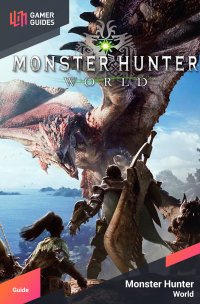| Quest Info |
|---|
| Objective: Hunt a Bazelgeuse |
| Reward Money: 14400z |
| Time Limit: 50 min. |
| Conditions: HR 13 or higher |
| Failure Conditions: Time Expires / Faint 3 Times |
| Other Monsters: Gastodon / Barnos / Gajalaka |
Oh, this has been a long time coming. The Legiana has been a persistent threat since you entered high rank mode, dropping in during expeditions and newer investigations and generally being a nuisance. Time for a little bit of payback. Not only does this stand to be a satisfying bit of vengeance, but the materials you can gain from a Bazelgeuse promise significant - if expensive - upgrades, regardless of your weapon selection or build, so it’s well worth going out of your way to hunt it.
Hunt - Bazelgeuse¶
| Elements | . |
|---|---|
| Fire | X |
| Water | * |
| Thunder | * * * |
| Ice | * * |
| Dragon | * * |
| Ailments | . |
|---|---|
| Poison | * * |
| Sleep | * * |
| Paralysis | * * |
| Blast | * |
| Stun | * |
The Bazelgeuse is a particularly flighty monsters, as should have been evidence by every previous encounter with it… in this case being “flighty” doesn’t necessarily mean it won’t stand and fight protracted battles, rather that the creature tends to travel around a lot before combat (like the Rathalos in the Ancient Forest tends to) and can quickly traverse areas mid-flight, putting its powers of flight to great advantage to reach elevations that’ll take you considerably more time to cover. This quest is no different, as the Bazelgeuse can be found on the heights of AREA 4, but it’ll also fly to AREAS 2, 3 and 9.
The main armament of the Bazelgeuse - aside from its massive body - are its explosive scales, which it deploys in various ways, usually before detonating them with its body, or with fiery breath. This is not a subtle monster, at its most elegant being the monster equivalent of a B-17 bomber, but it’s just as ready to shed bombs from its neck and detonate them by slamming its head down upon them. If this all sounds very similar to the Uragaan… well, you’re not wrong, save that the Uragaan tended to expel its bombs haphazardly, randomly restricting movement and causing incidental damage if you came into contact to (or got into close proximity with) its bombs. The Bazelgeuse is guilty of the same behavior, save it’ll actively employ its bomb-scales during attacks, and these can often make it more predictable… although stepping on the odd, randomly-shed explosive scale can still be a chance nuisance.
The Bazelgeuse has four clusters of explosive scales - two under each wing, one on the underside of its neck and one on its tail. Of these, the tail you can - and arguably should - actively target, as severing the tail will reduce the amount of bomb scales it can drop during attacks, and will generally make attacking the rear of the beast easier. Several of its less elegant attacks include dropping scales from its neck or tail before either charging over, flopping down on top of, or slamming its tail down upon the discharged scales, shortly causing them to explode.
In fact, the Bazelgeuse can largely be summed up as a fairly typical Flying Wyvern whose vulnerability windows are unique due to the delayed explosions accompanying many of its attacks. Learning the timing is a matter of practice, but generally, you should attack from the rear (going after the tail at first, then the stub of the tail when it has been severed), don’t be greedy with your attacks, and be ready to roll away from the monster when you see its explosive scales drop.
As a Flying Wyvern type monster, you should expect the “charge-back-and-forth” “attack” that those sorts of monsters tend to have, as well as the typical tail sweep - albeit the Bazelgeuse’s tail sweep obligatorily comes with added explosive scales - the flying leap followed by a ground slam (also accompanied by explosive scales if you don’t sever the tail), and the side rush. The Bazelgeuse can also slam its head into the ground, presaging a ground-grinding charge attack, and like most Flying Wyverns, it can breathe fire, although in this case its breath weapon is nothing special, being a short-ranged attack primarily used to detonate scales dropped for the purpose.
The most dangerous attack the Bazelgeuse has - which earns it the B-52 moniker - involves the Bazelgeuse taking to the air and flying in a line, shedding scales as it goes. Sometimes it’ll do more than one line, but it always intends to circle around and dive onto the ground, sliding over its previously discharged scales to cause a series of explosions. Not only is this a massively damaging diving charge attack in itself, but the explosions that go along with it can make it very tricky to keep an eye on the flying Bazelgeuse and avoid the bomb-scales it already dropped. On the other hand, when it’s flying around is an ideal time to introduce it to a Flash Pod.
Like all monsters, Bazelgeuse, when pressed, may get enraged, and where the Anjanath had its frills to let you know, the Bazelgeuse’s scales will start to ominously glow. Its attacks remain the same, albeit faster, but the explosive scales will now come pre-charged, liable to detonate shortly after hitting the ground whether the Bazelgeuse acts upon them or not. This will change the timing of its attacks somewhat, but the glowing orange bomb scales do give you a better “get the hell out of the way” visual cue. Most spectacularly, however, is the effect the Bazelgeuse’s rage will have on its bomber attack, turning it from a diving charge attack with explosive scales that serve as mines until detonated by said charge to an active bombing run.
Despite the Bazelgeuse being the last new monster you’ll fight before encountering the Elder Dragons, it’s still just a large monster, a wyvern, and can be captured.
The Bazelgeuse’s head, wings and body are all breakable, with the tail being severable. Removing the tail may limit the amount of explosive scales it can discharge during some attacks, and it’s not accident that all of its most vulnerable parts - the head, wings and tail - house clusters of explosive scales. The head takes the most damage overall, while the wings are only particularly weak to Ammo damage. Given its attacks, the tail is probably the safest target for a melee character, with the wings being a relatively easy target for a ranged character. The Bazelgeuse is weak to Thunder and resistant to Fire, and while it’s not terrible susceptible to any ailments, it’s most resilient to Blast and Stun.
| Carves | Frequency |
|---|---|
| Bazelgeuse Scale+ | * * * * * |
| Bazelgeuse Carapace | * * * * |
| Bazelgeuse Talon | * * * |
| Bazelgeuse Fuse | * * * |
| Bazelgeuse Wing | * * * |
| Bazelgeuse Gem | * |
| Rewards | Frequency |
|---|---|
| Bazelgeuse Carapace | * * * * |
| Bazelgeuse Scale+ | * * * * |
| Bazelgeuse Fuse | * * * |
| Bazelgeuse Talon | * * * |
| Bazelgeuse Wing | * * |
| Bazelgeuse Tail | * * |
| Monster Hardbone | * * * |
The Powertalon and Armortalon¶
While it’s normally been left up to you to determine what materials you need to grind for to create whatever gear and weapons suit your build and play-style best, the Bazelgeuse can drop materials that are universally useful. A while back you were informed that the Provisions Stockpile sold Powercharms and Armorcharms, which bestow a passive bonus to attack and defense so long as you kept them in your inventory. With the use of an Bazelgeuse Talon, you can upgrade these to a Powertalon and Armortalon, respectively.
To craft these, just go into your Crafting List menu and look for the last two items on the list, which may not be identified, but if a Powercharm or Armorcharm is one of the required crafting components, you should know what you’re looking at. In addition you’ll need a Bazelgeuse Talon for each item, and they’re an improvement over the base versions, otherwise functioning identically; just keep them in your inventory to gain passive buffs. Even better, their effects stack with the Powercharm and Armorcharm, so after you craft a Powertalon and Armortalon, consider purchasing another Powercharm and Armorcharm and keeping them in your inventory, too. It’s a lot of inventory spaces to use up, but the benefits are arguably worth it.

 Sign up
Sign up

No Comments